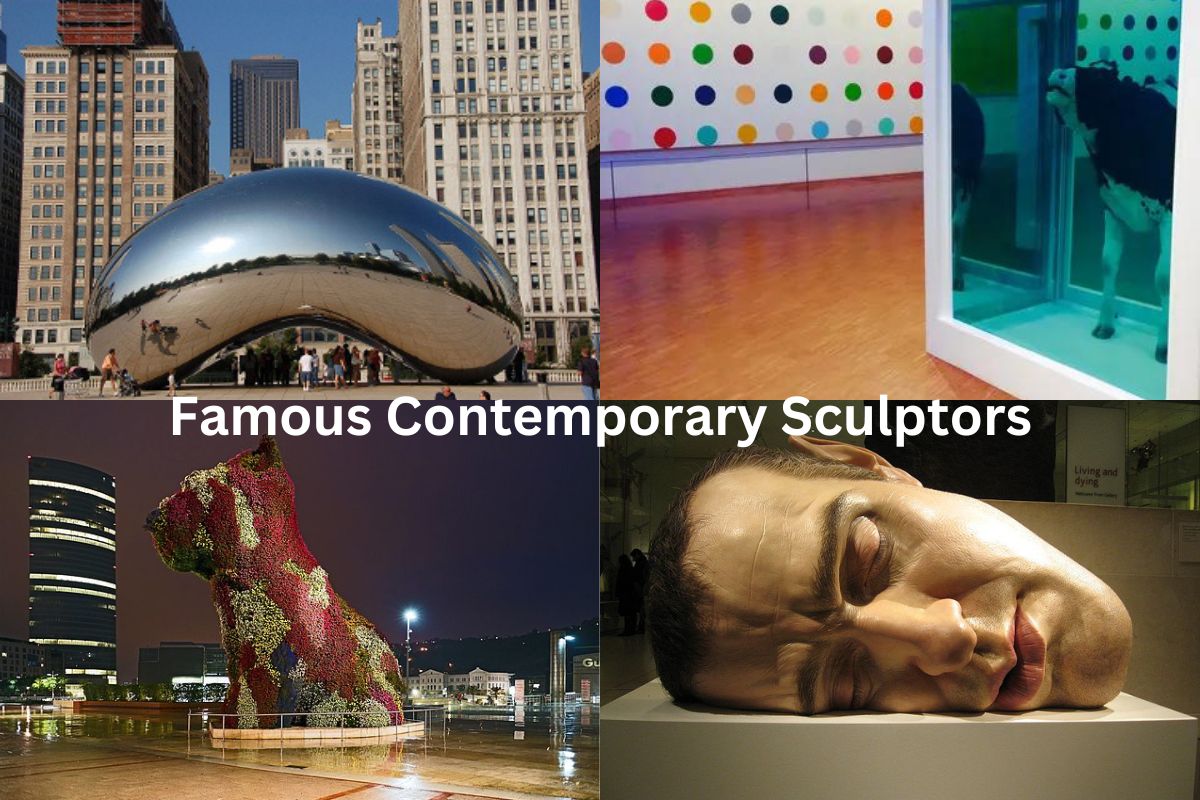Contemporary sculpture refers to the art of creating three-dimensional objects using a variety of materials such as stone, metal, wood, plastic, and even everyday objects.
In recent times, contemporary sculpture has evolved to encompass a broad range of styles, techniques, and subject matter.
Contemporary sculptors are those artists who have created works of art in the past few decades and have contributed significantly to the field of sculpture. They often experiment with new materials, forms, and techniques, pushing the boundaries of what is possible in sculpture.
Some contemporary sculptors have gained international recognition for their work and have created iconic sculptures that have become landmarks in cities around the world.
The work of contemporary sculptors reflects the diverse cultures, social and political issues, and artistic trends of our time, making it a vital part of the contemporary art scene.
Famous Contemporary Sculptors
1. Anish Kapoor
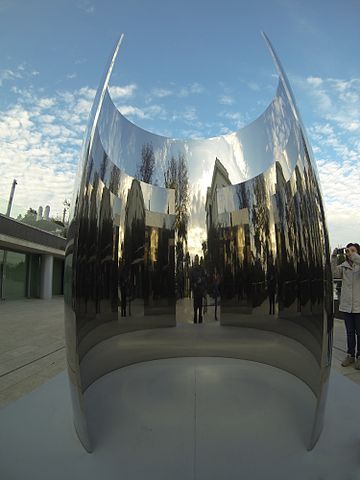
Anish Kapoor is an Indian-born British sculptor known for his large-scale, site-specific installations and reflective sculptures. Born in Mumbai in 1954, Kapoor moved to London in the early 1970s to study at the Hornsey College of Art and later at the Chelsea School of Art and Design.
Kapoor’s sculptures are often characterized by their use of simple forms and bold colors, which he uses to create striking and memorable works of art. He is known for his innovative use of materials, including pigment, steel, fiberglass, and wax, which he uses to create sculptures that are both visually stunning and conceptually complex.
Some of his most famous works include “Cloud Gate” (also known as “The Bean”), a reflective sculpture in Chicago’s Millennium Park, and “Sky Mirror,” a large-scale, mirror-polished stainless steel sculpture installed in various locations around the world.
Kapoor has won numerous awards for his work, including the Turner Prize in 1991 and a knighthood in 2013. His work has been exhibited in major museums and galleries around the world, including the Guggenheim Museum in New York, the Tate Modern in London, and the Louvre in Paris.
2. Jeff Koons
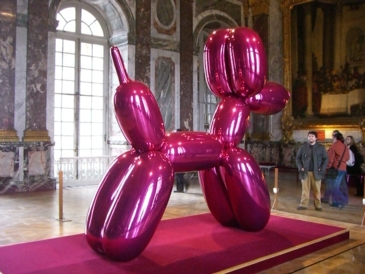
Jeff Koons is an American artist known for his highly polished, often kitschy sculptures of everyday objects, such as balloon animals, toys, and household appliances. Born in Pennsylvania in 1955, Koons studied art in Baltimore and Chicago before moving to New York in the late 1970s.
Koons’ work is characterized by its colorful, highly polished surfaces and its often provocative subject matter, which has included everything from sexually suggestive sculptures to works that celebrate consumer culture.
His work is often seen as a critique of the commercialization of art, and he has been both celebrated and criticized for his willingness to embrace commercialism and mass production.
Some of his most famous works include “Rabbit,” a stainless steel sculpture of a balloon animal that sold at auction for over $91 million, and “Balloon Dog,” a series of large-scale sculptures that have been installed in various locations around the world.
Koons has been the subject of numerous solo exhibitions at major museums around the world, including the Whitney Museum of American Art in New York, the Centre Pompidou in Paris, and the Guggenheim Bilbao in Spain. His work is held in the collections of many major museums, including the Museum of Modern Art in New York and the Tate Gallery in London.
3. Ai Weiwei
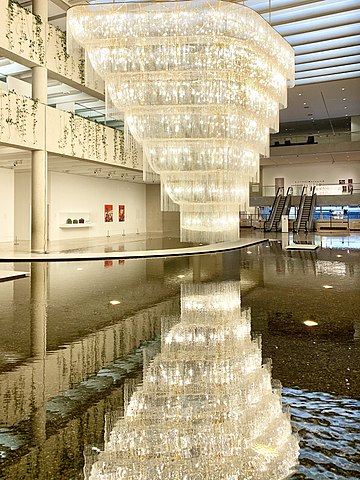
Ai Weiwei is a Chinese contemporary artist and activist known for his politically charged installations and sculptures that comment on social and cultural issues in China and around the world.
Born in Beijing in 1957, Ai Weiwei studied at the Beijing Film Academy and later lived in the United States for over a decade before returning to China in the early 1990s.
Ai’s work often tackles issues such as freedom of speech, government surveillance, and the impact of globalization on Chinese society. He frequently uses materials such as wood, ceramics, and marble to create large-scale installations that are both visually striking and conceptually powerful.
Some of his most famous works include “Sunflower Seeds,” an installation made up of millions of hand-painted porcelain sunflower seeds, and “Forever Bicycles,” a massive sculpture made up of thousands of bicycles arranged in a geometric pattern.
Ai Weiwei’s work has been exhibited in major museums around the world, including the Tate Modern in London, the Guggenheim Museum in New York, and the Hirshhorn Museum in Washington, D.C.
He has also been the subject of numerous documentaries and films, and has been an outspoken advocate for political freedom and human rights.
4. Damien Hirst
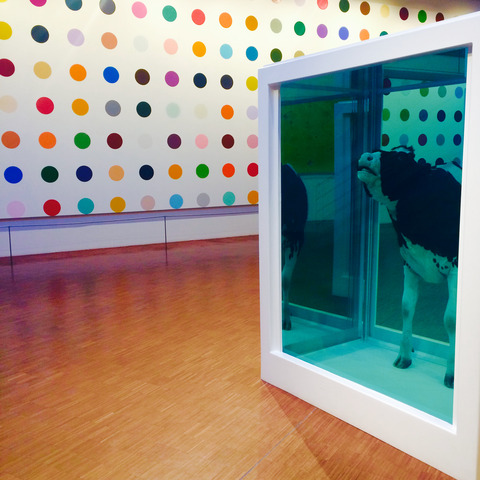
Damien Hirst is a British artist and entrepreneur known for his provocative and often controversial works, which often involve the use of dead animals and medical equipment. Born in Bristol in 1965, Hirst studied at Goldsmiths College in London, where he became one of the leading figures in the “Young British Artists” movement of the 1990s.
Hirst is best known for his series of “Natural History” works, which feature dead animals preserved in formaldehyde, as well as his “Spot” paintings, which consist of rows of brightly colored dots. He has also created sculptures made from materials such as glass, steel, and bronze.
Some of his most famous works include “The Physical Impossibility of Death in the Mind of Someone Living,” a shark preserved in formaldehyde, and “For the Love of God,” a platinum cast of a human skull covered in diamonds.
Hirst has been both celebrated and criticized for his willingness to embrace commercialism and his use of shock tactics in his work. He has been the subject of numerous solo exhibitions at major museums and galleries around the world, including the Tate Modern in London, the Museum of Contemporary Art in Tokyo, and the Gagosian Gallery in New York.
5. Antony Gormley
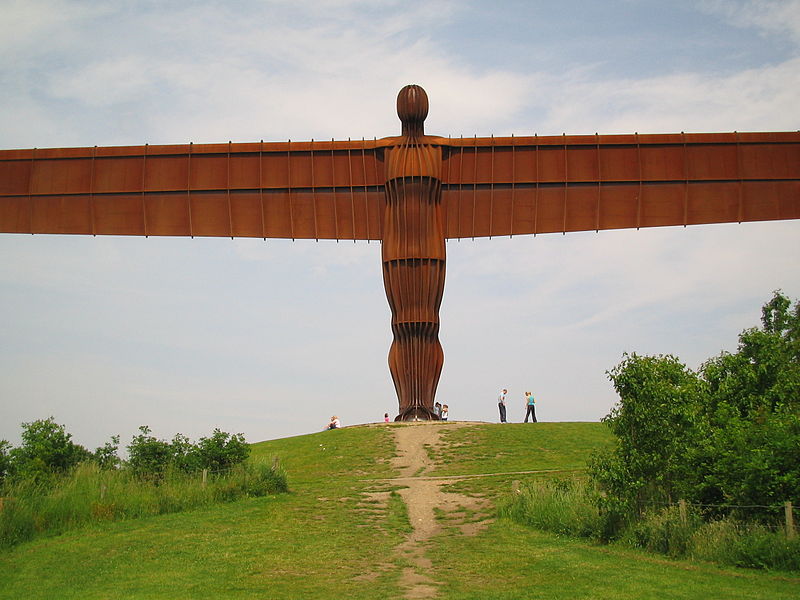
Antony Gormley is a British sculptor known for his life-size cast iron figures and installations that explore the relationship between the human body and the surrounding space. Born in London in 1950, Gormley studied art at Trinity College in Cambridge before later earning a postgraduate degree at Goldsmiths College in London.
Gormley’s work often involves the use of his own body as a model, which he casts in various materials to create sculptures that explore the human form and its relationship to the surrounding environment.
He has also created large-scale installations, such as “Angel of the North,” a 66-foot-tall sculpture of an angel with its wings outstretched, installed in Gateshead, England.
Some of his other famous works include “Another Place,” a series of 100 cast iron figures installed on a beach in Liverpool, and “Domain Field,” a sculpture made up of hundreds of small, identical figures arranged in a grid pattern.
Gormley has won numerous awards for his work, including the Turner Prize in 1994 and a knighthood in 2014. His work has been exhibited in major museums and galleries around the world, including the National Portrait Gallery in London, the Museum of Modern Art in New York, and the State Hermitage Museum in St. Petersburg, Russia.
6. Rachel Whiteread
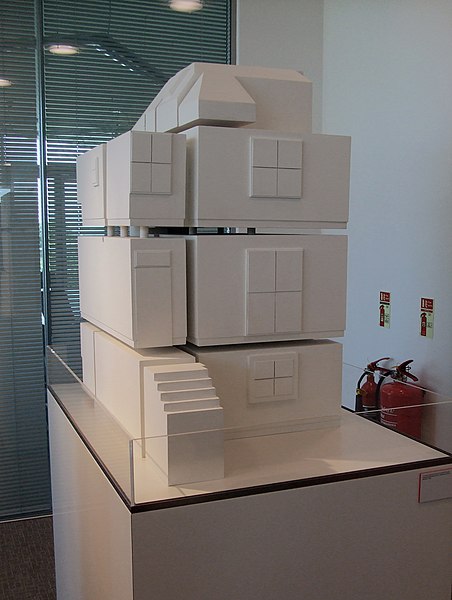
Rachel Whiteread is a British artist known for her sculptures and installations that explore the negative space left by objects and architecture. Born in London in 1963, Whiteread studied at the Slade School of Fine Art before later earning a postgraduate degree at the University of Vienna.
Whiteread’s work often involves the use of materials such as plaster, resin, and rubber to create casts of everyday objects and architectural elements, such as furniture, doors, and windows. By creating these casts, she highlights the often-overlooked negative space that surrounds and defines these objects.
Some of her most famous works include “House,” a concrete cast of the interior of a Victorian house that was later demolished, and “Ghost,” a plaster cast of the interior of a room that was installed in the Victoria and Albert Museum in London.
Whiteread has won numerous awards for her work, including the Turner Prize in 1993 and the Order of the British Empire in 2019. Her work has been exhibited in major museums and galleries around the world, including the Tate Modern in London, the Guggenheim Museum in New York, and the National Gallery of Art in Washington, D.C.
7. Ron Mueck
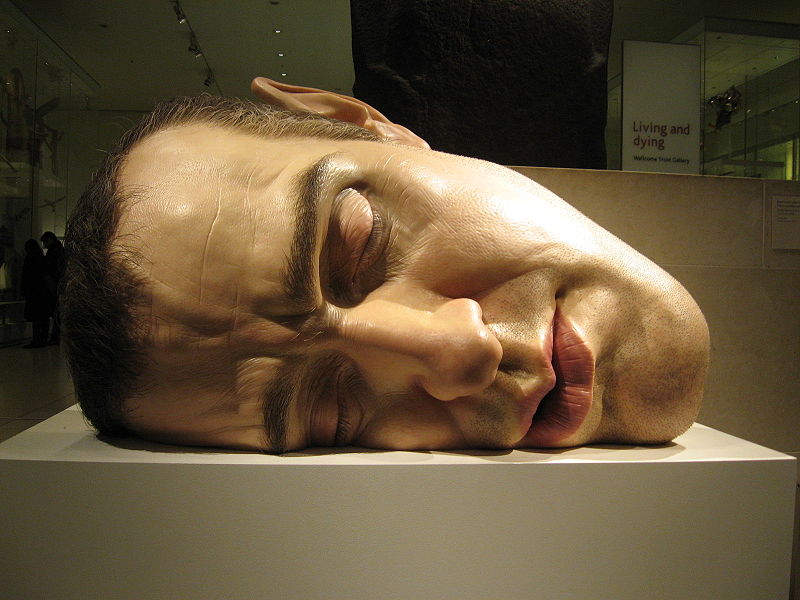
Ron Mueck is an Australian sculptor known for his hyper-realistic sculptures of human figures, often depicting them in extreme detail and scale. Born in Melbourne in 1958, Mueck began his career as a puppet maker and model maker for films and television before later turning to sculpture.
Mueck’s sculptures are often made from materials such as silicone, fiberglass, and resin, and are meticulously crafted to create a lifelike appearance. His sculptures often depict human figures in vulnerable or emotional states, and are sometimes distorted or exaggerated to create a surreal effect.
Some of his most famous works include “Dead Dad,” a sculpture of his own father lying in a hospital bed, and “Boy,” a giant sculpture of a naked teenage boy that was displayed at the Venice Biennale in 2001.
Mueck’s work has been exhibited in major museums and galleries around the world, including the Hirshhorn Museum and Sculpture Garden in Washington, D.C., the National Gallery of Victoria in Melbourne, and the Fondation Cartier in Paris.
8. Richard Serra
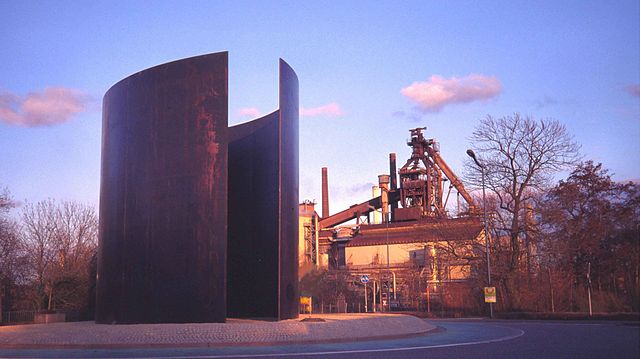
Richard Serra is an American sculptor known for his large-scale, site-specific installations made from industrial materials such as steel and concrete.
Born in San Francisco in 1938, Serra studied art at the University of California, Berkeley before later earning a master’s degree in fine arts from Yale University.
Serra’s sculptures often play with the viewer’s perception of space and scale, using large, monolithic forms to create a sense of awe and physical presence. His work is characterized by its rough, unfinished surfaces and its emphasis on the physicality of the materials he uses.
Some of his most famous works include “Tilted Arc,” a massive steel sculpture installed in New York City’s Federal Plaza in 1981 that was later controversially removed, and “Sequence,” a series of five large steel plates installed in the courtyard of the San Francisco Museum of Modern Art.
Serra has won numerous awards for his work, including the Golden Lion for sculpture at the Venice Biennale in 1986 and the Presidential Medal of Freedom in 2015.
His work has been exhibited in major museums and galleries around the world, including the Museum of Modern Art in New York, the Centre Pompidou in Paris, and the Guggenheim Museum Bilbao in Spain.
9. Olafur Eliasson
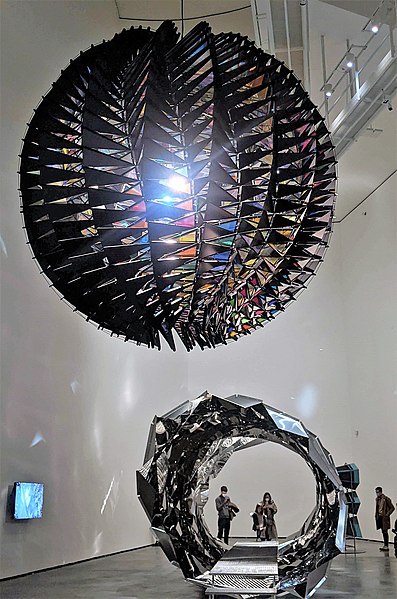
Olafur Eliasson is a Danish-Icelandic artist known for his immersive installations that often incorporate light and natural elements such as water and fog. Born in Copenhagen in 1967, Eliasson studied at the Royal Danish Academy of Fine Arts before later establishing his own studio in Berlin.
Eliasson’s work often plays with the viewer’s perception of space and color, creating environments that challenge and inspire the senses. His installations often feature interactive elements, such as mirrors or lenses, that encourage the viewer to become an active participant in the artwork.
Some of his most famous works include “The Weather Project,” an installation in the Turbine Hall of the Tate Modern in London that featured a giant sun made of lightbulbs and a reflective ceiling that gave the illusion of a sunset, and “Ice Watch,” a series of icebergs placed in public spaces around the world to draw attention to climate change.
Eliasson has won numerous awards for his work, including the Prince Eugen Medal in 2004 and the Louis Comfort Tiffany Foundation Award in 1999.
His work has been exhibited in major museums and galleries around the world, including the Museum of Modern Art in New York, the San Francisco Museum of Modern Art, and the Guggenheim Museum Bilbao in Spain.
10. Carl Andre
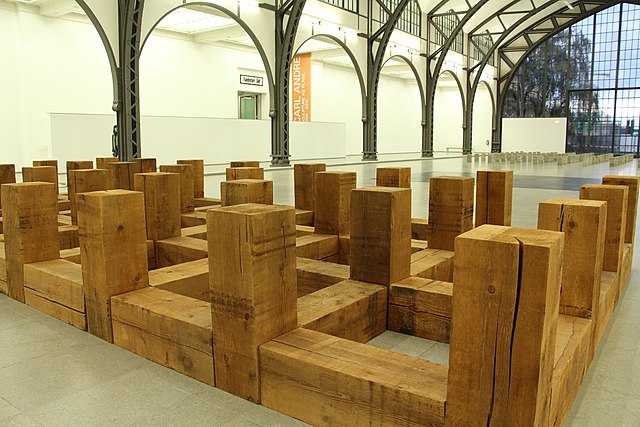
Carl Andre is an American minimalist artist known for his sculptural works made from industrial materials such as steel plates,bricks and wood. He was born on September 16, 1935, in Quincy, Massachusetts, and attended Phillips Academy in Andover, Massachusetts.
Andre’s early work was influenced by the poetry of William Carlos Williams and the paintings of Abstract Expressionists such as Jackson Pollock and Franz Kline. He began to make sculptures in the mid-1950s, and his first solo exhibition was held in 1965 at the Tibor de Nagy Gallery in New York.
In the 1960s, Andre began creating his signature sculptural works, which were made from raw, industrial materials such as steel plates, aluminum, and bricks.
He arranged these materials into geometric patterns, emphasizing the inherent qualities of the materials themselves. One of his most famous works is “Equivalent VIII” (1966), which consists of 120 fire bricks arranged in a rectangular grid on the floor.
Andre’s work has been the subject of controversy and criticism, particularly for his minimalist approach and the use of ordinary materials.
In 1970, he was one of several artists whose work was included in the exhibition “Information” at the Museum of Modern Art in New York, which was targeted by a bomb attack.

